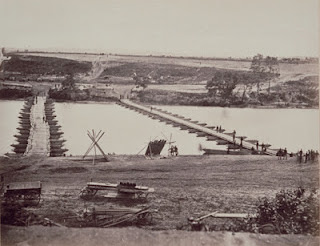'like any thin web-footed creature'.
 |
| Pontoon Bridges over the Rappahannock River in Virginia (1863-1864) |
Imagine the fate of an entire army hanging on a bridge that didn't exist the night before. During the Chancellorsville Campaign of 1863, Union General Joe Hooker relied on a remarkable innovation: pontoon bridges - portable, temporary structures that could be assembled under cover of darkness and vanish just as quickly. But what exactly were these floating lifelines, and how did engineers pull off such feats under enemy fire? Thanks to a letter from Private Jason Doten of Company B, 2nd Battery, 1st Maine Volunteer Light Artillery, we get a rare, firsthand look at the ingenuity and grit behind these wartime marvels - a story of sweat, strategy, and the race against the river itself.
"We were detached for a time as an Engineer Corps to lay a Pontoon Bridge across the Rappahannock for the troops to cross on to march on Richmond... I like this business very well so far, but I do not know when we will get orders to lay the Bridge." [1]
Despite being so close to the Confederate forces across the river, Doten maintained a sense of humor about the tense situation, joking that he expected to "hear some music" (a battle) soon. And he was right—his unit went into action days later at the Battles of Williamsburg and Front Royal.
Dad, Here’s How a Pontoon Bridge Works
By July 1862, the battery had returned to Washington, D.C., for some much-needed rest. With more time on his hands, Doten indulged his father’s curiosity about pontoon bridges. He explained in a detailed letter.
"...they think the ponton [sic] Bridge is hardly fit for a statonary Bridge or to lay a very long time, it is first rate to lay down for foot soldiers to cross on but is hardly fit for heavy teams to cross on, altho they did there to Falmouth. [They were] used for everything for a long time as the Rebels burned all the Bridges when they left."
Doten described the construction process in detail. His enthusiasm—and occasional frustration—shines through as he attempts to describe something his father had never seen.
The bridge, he explained, was made of 3 components: boats, beams, and planks(or stringers). The boats were made of rubber or some similar material that could be inflated with "bellows". They were anchored in place, with wooden beams (called bawks) laid across them. These beams were then topped with planks (known as ches) to create a flat surface for crossing. The boats - divided into airtight compartments to prevent sinking - were a marvel of wartime engineering.
Doten then used an interesting simile to help his father visualize the finished product:
"The boats are like three logs, of the shape of a canoe on the bottom, joined together like any thin web-footed creature."
From Rubber Boats to Rolling Trains
After his explanation of the bridge construction was complete, Doten described for his father how all of this was "portable" - that is, getting a dismantled bridge to the desired site for use. The pontoon bridge components—boats, beams, planks, and tools—were packed into a massive convoy known as a "ponton [sic] train." This train of 50 wagons carried everything needed to set up a bridge at a moment’s notice. The boats, deflated for transport, fit into specially marked boxes stowed on the wagons.
Doten captured the logistical scale of this operation in his letter:
"Each wagon has one boat or just one length of bridge. The wagons are all numbered... and are marked U.S. Ponton Train, so I guess you will know what a ponton train is.”
His pride in the ingenuity and efficiency of this system is unmistakable.
Bridging the Gap
Jason Doten’s letters offer a fascinating window into the resourcefulness of Civil War soldiers and the innovative engineering that helped shape Union military strategy. Through his humor, patience, and vivid descriptions, we can better appreciate the effort that went into constructing the portable bridges like the ones above that made campaigns like Chancellorsville possible. It’s a reminder that even in the chaos of war, creativity and problem-solving had their place on the battlefield.
.jpg) |
| A Pontoon bridge near Petersburg, Virginia, in April of 1865. |
This is one of the millions of forgotten stories from the Irrepressible Conflict.
Mac
═══ ⚔ 𝑻𝒂𝒌𝒆 𝒕𝒉𝒆 𝑪𝒐𝒍𝒐𝒓𝒔 ⚑ ═══
[FYI] If you’re interested in learning more, there is an excellent reference book on pontoon bridges in the Civil War. It’s a 1997 reprint of Colonel Wesley Brainerd’s experiences with the 50th New York Volunteer Engineers: Brainerd, Wesley (1997) Bridge Building in Wartime.
Works Cited
[1] "Jason L. Doten Letters" (1862). Civil War Letters, Auburn University Digital Collections. Retrieved April 19, 2025.
No comments:
Post a Comment